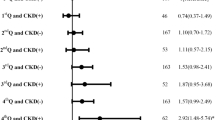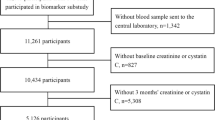Abstract
Renal insufficiency is associated with the prognosis of acute ischemic stroke (AIS) and homocysteine (Hcy) levels. This study investigated the association between plasma Hcy levels and renal insufficiency in patients with AIS. A total of 987 patients with AIS who had been treated at the First People’s Hospital of Foshan between 2011 and 2014 were retrospectively studied. Based on their cystatin C (Cys C) levels, the patients were divided into the normal renal function group (Cys C ≤ 1.25 mg/L) or the renal impairment group (Cys C > 1.25 mg/L). Multivariate regression analysis was applied to reveal the association between hyperhomocysteinemia (HHcy) and renal impairment. The renal impairment group showed more advanced age of onset, higher percentage of prior stroke and hypertension, higher baseline National Institute of Health Stroke Scale score, lower high-density lipoprotein cholesterol levels, and higher Hcy levels compared with the normal renal function group. A multivariate analysis revealed a relationship between early renal impairment and Hcy levels: an increase of Hcy by 1 μmol/L was associated with an increase of 12–18% of the risk of renal impairment among patients with AIS and HHcy. Patients with AIS and HHcy had a 2.42–3.51 fold increase of the risk of renal impairment compared with patients with normal Hcy level (P < 0.001). In conclusion, patients with stroke and HHcy could be more prone to renal impairment.
Similar content being viewed by others
References
Brattstrom L, Wilcken DE (2000) Homocysteine and cardiovascular disease: cause or effect? Am J Clin Nutr 72:315–323
CMA (2010) Editor team on treatment guidelines of acute ischemic stroke from Cerebrovascular Diseases Study Group in neurology branch of Chinese Medical Association. China acute ischemic stroke treatment guidelines. J Neurol 43:146–153
Coll E et al (2000) Serum cystatin C as a new marker for noninvasive estimation of glomerular filtration rate and as a marker for early renal impairment. Am J Kidney Dis 36:29–34. doi:10.1053/ajkd.2000.8237
Cui R et al (2008) Serum total homocysteine concentrations and risk of mortality from stroke and coronary heart disease in Japanese: the JACC study. Atherosclerosis 198:412–418. doi:10.1016/j.atherosclerosis.2007.09.029
Gensicke H et al (2013) IV thrombolysis and renal function. Neurology 81:1780–1788. doi:10.1212/01.wnl.0000435550.83200.9e
Graham IM et al (1997) Plasma homocysteine as a risk factor for vascular disease. The European Concerted Action Project JAMA 277:1775–1781
Han H et al (2001) Serum cystatin C is an independent predictor of total homocysteine levels in stable Korean renal transplant recipients with normal serum creatinine. J Ren Nutr 11:149–154
Helmersson-Karlqvist J, Arnlov J, Carlsson AC, Harma J, Larsson A (2014) Increased urinary cystatin C indicated higher risk of cardiovascular death in a community cohort. Atherosclerosis 234:108–113. doi:10.1016/j.atherosclerosis.2014.02.020
Homocysteine Studies C (2002) Homocysteine and risk of ischemic heart disease and stroke: a meta-analysis. JAMA 288:2015–2022
Huo Y et al (2015) Efficacy of folic acid therapy in primary prevention of stroke among adults with hypertension in China: the CSPPT randomized clinical trial. JAMA 313:1325–1335. doi:10.1001/jama.2015.2274
Ingelfinger JR, Marsden PA (2013) Estimated GFR and risk of death–is cystatin C useful? N Engl J Med 369:974–975. doi:10.1056/NEJMe1308505
Ji Y et al (2015) Prognostic significance of homocysteine levels in acute ischemic stroke: a prospective cohort study. Curr Neurovasc Res 12:334–340
Kalra DK (2004) Homocysteine and cardiovascular disease. Curr Atheroscler Rep 6:101–106
Leach NV et al (2014) Serum homocysteine levels, oxidative stress and cardiovascular risk in non-alcoholic steatohepatitis. Eur J Intern Med 25:762–767. doi:10.1016/j.ejim.2014.09.007
Li Z et al (2003) Elevated plasma homocysteine was associated with hemorrhagic and ischemic stroke, but methylenetetrahydrofolate reductase gene C677T polymorphism was a risk factor for thrombotic stroke: a multicenter case–control study in china. Stroke 34:2085–2090. doi:10.1161/01.STR.0000086753.00555.0D
Li JP, Huo Y, Liu P (2007) Efficacy and safety of Enalapril-Folate acid tablets in lowering blood pressure and plasma homocysteine. Beijing Da Xue Xue Bao 39:614–618
Liu D, Ding H, Liu S, Shen J (2012) Estimated glomerular filtration rate decline in 567 patients with acute stroke. Scand J Urol Nephrol 46:142–147. doi:10.3109/00365599.2011.639032
Luo Y et al (2014) Association of glomerular filtration rate with outcomes of acute stroke in type 2 diabetic patients: results from the China National Stroke Registry. Diabetes Care 37:173–179. doi:10.2337/dc13-1931
Power A (2013) Stroke in dialysis and chronic kidney disease. Blood Purif 36:179–183. doi:10.1159/000356086
Sacco RL, Anand K, Lee HS, Boden-Albala B, Stabler S, Allen R, Paik MC (2004) Homocysteine and the risk of ischemic stroke in a triethnic cohort: the Northern MAnhattan Study. Stroke 35:2263–2269. doi:10.1161/01.STR.0000142374.33919.92
Sacco RL et al (2006) Guidelines for prevention of stroke in patients with ischemic stroke or transient ischemic attack: a statement for healthcare professionals from the American Heart Association/American Stroke Association Council on Stroke: co-sponsored by the Council on Cardiovascular Radiology and Intervention: the American Academy of Neurology affirms the value of this guideline. Circulation 113:e409–e449
Saeed F, Kousar N, Qureshi K, Laurence TN (2009) A review of risk factors for stroke in patients with chronic kidney disease. J Vasc Interv Neurol 2:126–131
Sarkar PK, Lambert LA (2001) Aetiology and treatment of hyperhomocysteinaemia causing ischaemic stroke. Int J Clin Pract 55:262–268
Stanger O et al (2003) DACH-LIGA homocystein (german, austrian and swiss homocysteine society): consensus paper on the rational clinical use of homocysteine, folic acid and B-vitamins in cardiovascular and thrombotic diseases: guidelines and recommendations. Clin Chem Lab Med 41:1392–1403. doi:10.1515/CCLM.2003.214
Suliman ME, Lindholm B, Barany P, Bergstrom J (2001) Hyperhomocysteinemia in chronic renal failure patients: relation to nutritional status and cardiovascular disease. Clin Chem Lab Med 39:734–738. doi:10.1515/CCLM.2001.122
Toole JF et al (2004) Lowering homocysteine in patients with ischemic stroke to prevent recurrent stroke, myocardial infarction, and death: the vitamin intervention for stroke prevention (VISP) randomized controlled trial. JAMA 291:565–575. doi:10.1001/jama.291.5.565
Towfighi A, Markovic D, Ovbiagele B (2010) Pronounced association of elevated serum homocysteine with stroke in subgroups of individuals: a nationwide study. J Neurol Sci 298:153–157. doi:10.1016/j.jns.2010.07.013
Ueland PM, Refsum H (1989) Plasma homocysteine, a risk factor for vascular disease: plasma levels in health, disease, and drug therapy. J Lab Clin Med 114:473–501
Wang H, Cui K, Xu K, Xu S (2015) Association between plasma homocysteine and progression of early nephropathy in type 2 diabetic patients Int J. Clin Exp Med 8:11174–11180
Xu X (2008) Effective control of H-type hypertension: new ideas for stroke prevention. Chin J Integr Med 47:976–977
Yahalom G et al (2009) Chronic kidney disease and clinical outcome in patients with acute stroke. Stroke 40:1296–1303. doi:10.1161/STROKEAHA.108.520882
Zhang W et al (2010) High plasma homocysteine levels contribute to the risk of stroke recurrence and all-cause mortality in a large prospective stroke population. Clin Sci (Lond) 118:187–194. doi:10.1042/CS20090142
Acknowledgement
The present work was sponsored and funded by the Science and technology project of Guangdong Province, China (No.: 2010B080702029). We thank the chief physicians of the neurology department of the First People’s Hospital of Foshan, Dr. Chengguo Zhang and Dr. Yukai Wang, for their suggestions, assistance, and supervision in study design. We also thank the staff of the neurology and medical care departments for their help in data collection. Lastly, we thank the department of clinical laboratory for providing the laboratory instruments and experiment protocols and assisting in testing the blood samples.
Author information
Authors and Affiliations
Corresponding author
Ethics declarations
Conflict of interest
The authors declare that they have no conflict of interest.
Ethical Approval
All procedures performed in studies involving human participants were in accordance with the ethical standards of the institutional and/or national research committee and with the 1964 Helsinki Declaration and its later amendments or comparable ethical standards.
Informed Consent
Informed consent was obtained from all individual participants included in the study.
Additional information
Jingjuan Chen, Guode Li and Zuohang Xu contributed equally to this work.
Rights and permissions
About this article
Cite this article
Chen, J., Li, G., Xu, Z. et al. Elevated Plasma Homocysteine Level Increased the Risk of Early Renal Impairment in Acute Ischemic Stroke Patients. Cell Mol Neurobiol 37, 1399–1405 (2017). https://doi.org/10.1007/s10571-017-0470-8
Received:
Accepted:
Published:
Issue Date:
DOI: https://doi.org/10.1007/s10571-017-0470-8




